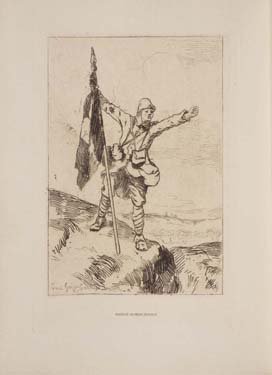The Battle
No single image could possibly convey the horror of the Great War's battlefields. Some illustrators relied on traditional representations, adapting the conventions of nineteenth-century history painting, but substituting contemporary uniforms for the combatants. Others, who had experienced the war firsthand, such as Charles Martin or Fernand Léger, captured the despair of the conflict by more oblique means.
Paul Guignebault. Paris: Maurice Glomeau, 1916
Gift of Neil Harris and Teri J. Edelstein
An established, exhibited artist before the war, Paul Guignebault had already illustrated books, sometimes made in tandem with his teacher, Henri Boutet. Here, he provided a frontispiece of a French soldier, holding the tricolere and urging his comrades forward. Perhaps the texts in this pocket-size volume were also meant as an encouragement to those waging battle. Its verses and epigrams feature among others Pascal, Racine, Saint Augustine, Robespierre, Hugo, and Napoleon.
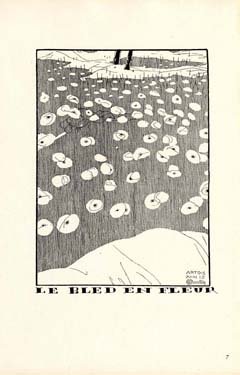
Charles Martin. Sous les pots de fleurs. Paris: Jules Meynial, 1917
Gift of Neil Harris and Teri J. Edelstein
An established illustrator before the war, Charles Martin served in the infantry. The title of this wartime publication, Sous les pots de fleurs (Under the flowerpots), is actually a contrepèterie, or spoonerism, for sous les flots de peur, beneath the waves of fear. The first full-page illustration, "Le bled en fleur," depicts a wheat field dotted with poppies—the farmland that became battlefields—and a body amid the wheat. Later, poppies came to symbolize endless drops of blood and, because of the popularity of the poem "In Flanders Fields" by the Canadian medical officer John McCrae, to commemorate the war itself.
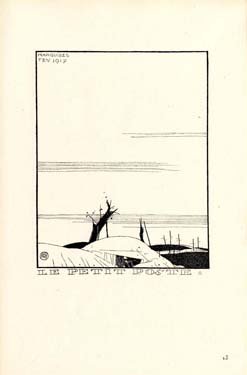
Charles Martin. Sous les pots de fleurs. Paris: Jules Meynial, 1917
Gift of Neil Harris and Teri J. Edelstein
The illustrations in the book cover the period from 1915 to 1917 but are arranged not in chronological but in a powerful visual order. Here we see the scene of "Le cafard" in 1916 from a different perspective. The trench warfare continued. Martin showed us the scorched earth and blasted trees of no-man's-land stretching to the horizon. In France, the early optimism about the war's brief duration had now turned into a pessimism that it would extend to infinity, like the desolation of the landscape.
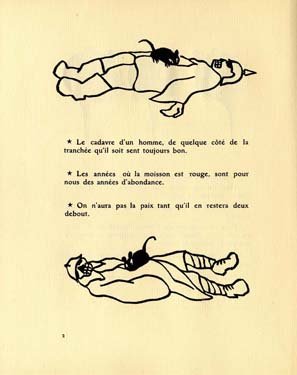
Lucien Descaves. Illus. by Lucien Laforge. Paris: Librarie Ollendorff, 1920
On loan from a private collection
By the 1920s a number of avant-garde German artists had created searing indictments of war. For example, the 1924 portfolio of fifty-one prints, "Der Krieg" (War) by Otto Dix portrayed the struggle as a series of scenes from hell. Nothing of such power emerged from France in that period but Lucien Laforge turned his style from witty to crude for his depiction of the triumph of the rats in Descaves's tale. Although the rats declare that years when the harvest is red are for them years of abundance, Laforge wisely eschewed color for his images. The rats have no allegiance, feasting happily on cadavers from both sides of the conflict.
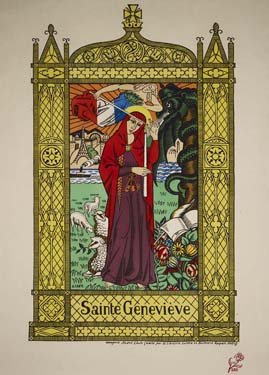
André Lhote. Paris: Librairie Lutetia, 1914
On loan from the Kislak Center for Special Collections, Rare Books & Manuscripts, University of Pennsylvania
Image permissions: Devambez; Kislak Center for Special Collections, Rare Books & Manuscripts; ©2014 Artists Rights Society (ARS), New York/ADAGP, Paris
The modernist artist André Lhote's brilliantly colored monumental print, executed for Librairie Lutetia in an edition of five hundred copies, evokes French medieval stained-glass windows in which a saint is frequently shown within a Gothic architectural framework. Sainte Geneviève depicts the defense of France. The cityscape of Paris, dominated by the Seine and the Eiffel Tower, is in the background. The country is defended against the German dragon, which disturbs the peace of a garden filled with flowers and populated by lambs. If religion is not enough, an allegorical figure of France, clad in the tricolore, aids the patron saint of Paris.
